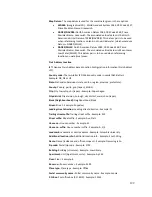
124
Tag:
Tag indicate whether the specified application type is using a 'tagged' or an
'untagged' VLAN.
Untagged indicates that the device is using an untagged frame format and as such
does not include a tag header as defined by IEEE 802.1Q-2003. In this case, both the
VLAN ID and the Layer 2 priority fields are ignored and only the DSCP value has
relevance.
Tagged indicates that the device is using the IEEE 802.1Q tagged frame format, and
that both the VLAN ID and the Layer 2 priority values are being used, as well as, the
DSCP value. The tagged format includes an additional field known as the “Tag
Header”. The tagged frame format also includes priority tagged frames as defined by
IEEE 802.1Q-2003.
VLAN ID:
VLAN identifier (VID) for the port as defined in IEEE 802.1Q-2003.
L2 Priority:
L2 Priority is the Layer 2 priority to be used for the specified application
type. L2 Priority may specify one of eight priority levels (0 through 7), as defined by
IEEE 802.1D-2004. A value of 0 represents use of the default priority as defined in
IEEE 802.1D-2004.
DSCP:
DSCP value to be used to provide Diffserv node behavior for the specified
application type as defined in IETF RFC 2474. DSCP may contain one of 64 code point
values (0 through 63). A value of 0 represents use of the default DSCP value as
defined in RFC 2475.
Adding a new policy:
Click to add a new policy. Specify the application type, tag,
VLAN ID, L2 priority and DSCP for the new policy. Click "Save".
Port Policies Configuration:
Every port may advertise a unique set of network policies or different attributes for
the same network policies, based on the authenticated user identity or port
configuration.
Port:
The port number to which the configuration applies.
Policy Id:
The set of policies shall apply to a given port. The set of policies is selected
by marking the checkboxes that corresponds to the policies.
Buttons:
Apply –
Click “Apply” to save changes.
Reset-
Click “Reset” to undo any changes made locally and revert back to
previously saved values.
















































